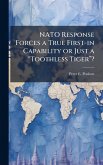The evolution of the Strategic Concept, the North Atlantic Treaty Organization's (NATO) blueprint for its approach to the global security environment, has undergone substantial change during the last ten years. These changes reflect the vastly different international world order precipitated by the fall of the Berlin Wall and the collapse of the Soviet Union. The United States, as a member of NATO, has been equally involved with the developments of the post bi-polar world. It has begun to restructure its military in an attempt to better respond to the full-spectrum of conflict and higher tempo of contemporary operations. The potential for complex multinational operations, coupled with the unique military and strategic dynamics found within such an environment, will ultimately demand a higher level of understanding of such operations from members of the United States Army. Using a contemporary analytical strategy to explore the development of NATO's Strategic Concept, coupled with an examination of Army service specific doctrine, this monograph will answer the problem statement of this research: Is the United States Army aware of the operational ramifications contained within NATO's new strategic concept? The most visible evidence of alliance understanding and awareness rests within the cornerstone publications and service doctrine. This monograph concludes that there is insufficient attention paid to alliance and multinational operations within its doctrine and manuals and points to After Action Reviews from Kosovo and Bosnia to support these findings. The extensive experience accumulated by U.S. Army commanders since the signing of the Dayton Peace Accords must be cultivated and ultimately integrated into future doctrine development. This work has been selected by scholars as being culturally important, and is part of the knowledge base of civilization as we know it. This work was reproduced from the original artifact, and remains as true to the original work as possible. Therefore, you will see the original copyright references, library stamps (as most of these works have been housed in our most important libraries around the world), and other notations in the work. This work is in the public domain in the United States of America, and possibly other nations. Within the United States, you may freely copy and distribute this work, as no entity (individual or corporate) has a copyright on the body of the work. As a reproduction of a historical artifact, this work may contain missing or blurred pages, poor pictures, errant marks, etc. Scholars believe, and we concur, that this work is important enough to be preserved, reproduced, and made generally available to the public. We appreciate your support of the preservation process, and thank you for being an important part of keeping this knowledge alive and relevant.
Bitte wählen Sie Ihr Anliegen aus.
Rechnungen
Retourenschein anfordern
Bestellstatus
Storno








